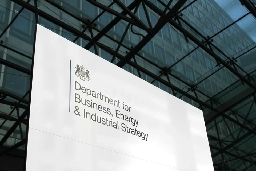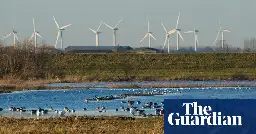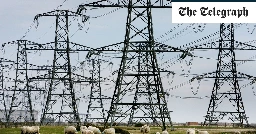- www.yorkshirepost.co.uk England's largest onshore wind farm in Yorkshire 'would be catastrophic for nature'
Campaigners have warned that building England’s largest onshore wind farm on protected peatland would be “catastrophic for carbon storage, wildlife and flood risk”.

> Campaigners have warned that building England’s largest onshore wind farm on protected peatland would be “catastrophic for carbon storage, wildlife and flood risk”. Saudi-backed developer World Wide Renewable Energy Global Ltd wants to construct the farm on more than 2,300 hectares at Walshaw Moor, between Hebden Bridge and Haworth. > > Consisting of up to 65 wind turbines, it would be capable of generating up to 302MW of energy. > > The developer said last September that it would establish a £75m community benefit fund and also pledged to end grouse shooting if it was granted planning permission. > > However, campaigners say it would impact endangered birds, like curlew, lapwing, skylark and merlin, and exacerbate already serious local flooding. > > The huge development would need 22 miles of access roads and 160 tonnes of reinforced concrete for each of the gigantic turbines. > > At 200m tall (655ft), the turbines would be 20m higher than London’s 41-storey Gherkin building. > > Campaigners say turbine construction and the associated infrastructure will affect hydrology, causing peatlands to dry out to such an extent that they will become a net emitter of carbon rather than a carbon sink.
- news.sky.com Energy supplier OVO to explore options including sale
OVO Group, the UK's fourth-biggest home energy provider, is lining up bankers at Rothschild to assist with a review of its strategic and financing options, Sky News learns.

> Britain's fourth-biggest household energy supplier is lining up bankers to explore options including bringing in a new investor or a sale, 15 years after it launched in a bid to challenge the industry's oligopoly. > > Sky News has learnt that OVO Group, which was founded by Stephen Fitzpatrick, is close to hiring Rothschild to assist with a strategic review of the business. > > City sources said this weekend that a range of possibilities would be considered during the process, which is expected to take several months. > > These are likely to include a refinancing - with talks already underway about OVO's existing borrowings - as well as issuing new shares to prospective investors, or a partial or full sale by some of the company's shareholders. > > An outright sale of the business is considered by insiders to be unlikely at this point, but is expected to be explored as part of the strategic review. > > ... > > Key to OVO's valuation will be the growth of its technology platform, Kaluza, which was set up to license its software to other energy suppliers, and provides customers with smart electric vehicle charging and heat pumps. > > OVO recently announced that AGL Energy, one of Australia's biggest energy suppliers, had bought a 20% stake in Kaluza at a $500m (£395m) valuation. > > Kaluza is understood to be exploring further expansion opportunities in Europe, Japan and the US. > > OVO has also entered the electric vehicle car charging sector under the brand Charge Anywhere, adding 34,000 public charging points across the UK. > > In 2022, OVO Group made an unadjusted loss of £1.3bn, which it blamed on a decline in the value of energy it had bought in advance to meet future supply commitments. > > It said this had "no cash impact" in a corporate filing, and that this value would rise as customers used the energy it had bought.
-
National Grid to offer year-round cash for cutting power use
www.energylivenews.com National Grid to offer year-round cash for cutting power use - Energy Live NewsThe electricity system operator has confirmed that the demand flexibility service will reward UK households with financial incentives for reducing their electricity consumption at any time of the year

> The electricity system operator has confirmed that the demand flexibility service will reward UK households with financial incentives for reducing their electricity consumption at any time of the year
- www.yorkshirepost.co.uk Plans for hydrogen-powered peaking plant on Yorkshire's coastline 'a lot bigger' than locals expected
Plans for a hydrogen-powered peaking plant - a first for the UK - are expected to be submitted to East Riding Council this month.

> SSE Thermal's £350m to £400m 50MW project would see hydrogen produced and stored at a site near Aldbrough on Yorkshire's coast before being used to power a turbine to create electricity to feed into the grid at times of peak demand. > > One of the main challenges with intermittent renewables like offshore wind is how to store the excess energy - hydrogen is an alternative to batteries. > > Hydrogen would be manufactured using "low carbon" electricity, delivered via an existing substation at the site, to split water into its component parts. > > It would then be stored in an underground cavern 1.8 kilometres down in a layer of rock salt, previously used to store natural gas. > > ... > > Residents at an event at Aldbrough on Thursday were told it would be the "first power station at this scale in the UK and pretty much the world". > > Attendees were able to see what the site will look like from any chosen viewpoint nearby using an interactive tool. > > Some were dismayed by its size and concerned by creeping industrialisation of the coastline - it will have a 30m high stack and the turbine will be 14m high. > > One resident said it will "look like a chemical factory" and was a "lot bigger" than she'd anticipated.
-
Meet the Highland wind power pioneers with no energy bills
> A small community of similarly minded folks had also settled in Scoraig, and he would bring a particular skill: Cambridge University educated with a background in maths and physics, he was about to become Scotland’s wind power pioneer. > > Today, largely thanks to Hugh, Scoraig’s 70 or so residents are in the enviable position of never having to fear the electricity bill: they rely on wind and solar power for their energy needs, topped up when there’s really no alternative using wood, bottled gas and oil. > > But that’s few and far between, says Hugh, pointing out that his 20-year-old bungalow has been so efficiently insulated and heated using hot water powered by his renewables system, that even in the depths of winter there’s no real need to resort to wood, coal or any other heating source. > > Indeed, he can usually comfortably run all the electrical goods he needs, cost free. > > “I have never had an electricity bill since I lived here and that’s 50 years ago,” he says. “I have all the mod cons; I have a dishwasher, all the normal appliances and they work great.
- www.theguardian.com British Gas boss says all UK households should be forced to fit smart meters
Chris O’Shea, CEO of Centrica, says mandatory installation programme would cut cost of creating a smart grid

> The boss of British Gas has called for households to face mandatory smart meter installations weeks after government figures showed that almost 4m meters are not working. > > Chris O’Shea, the chief executive of the British Gas owner Centrica, told a committee of MPs that smart meters should be installed in all homes through a “street by street” programme, in order to cut the costs of creating a smart grid. > > The energy boss, who has come under fire after British Gas was revealed to have used debt collectors to force-fit prepayment meters in vulnerable customers’ homes, said the company would be willing to install smart meters on behalf of other energy suppliers. > > ... > > The government launched its smart meter programme in 2011 and had hoped to install smart meters in households across the UK before 2020 to help reach its net zero ambitions. About 60% of homes have a smart meter, according to government data. > > Smart meters are considered a key tool in helping households reduce their energy use. They use real-time data to make better use of renewable energy when it is available and cut the need for fossil fuels, as well as relaying instant data on households’ energy use. > > But the programme, which is being carried out by energy suppliers, has been dogged by delays and technical faults. The government’s recent data suggested that customers with smart meters may have been overcharged on their gas and electricity bills.
- www.standard.co.uk Small firms urge Ofgem to act over spiralling energy standing charges on bills
One small business owner claimed their standing charge had grown 13 times bigger in three years, the Federation of Small Businesses said.

> A growing number of small businesses are complaining of vastly inflated standing charges on top of their standard energy bills, some as much as 13 times the level of three years ago. > > The Federation of Small Businesses (FSB) has written to Ofgem, urging it to act over fast-growing standing charges paid by small companies, particularly those in rural areas. > > One business owner got in touch with the group to report an increased standing charge, from 70.94p per day in July 2021 to 969.64p per day in September 2023, more than 13 times higher. > > Standing charges are applied daily, regardless of how much energy the customer uses, and are used to cover the cost of supplying energy to homes and businesses. > > They also cover the costs of building new network infrastructure and keeping the power on when energy suppliers go bust. > > While consumers’ bills are limited by the energy price cap, small businesses’ are not. > > Tina McKenzie, FSB policy chairwoman, said: “We want Ofgem to do a thorough review of standing charges for businesses as well as consumers, for better transparency and to discern whether energy companies are behaving fairly towards their small firm clients.
- www.standard.co.uk Share of electricity from gas and coal hits hour-long record low of 2.4%
The new low for fossil fuels’ contribution to British grid lasted for an hour at lunchtime on April 15, Carbon Brief analysis shows.

> The share of power coming from fossil fuels hit the new low at lunchtime on Monday April 15 and lasted for an hour, climate and energy website Carbon Brief said. > > Analysis of National Grid Electricity System Operator (ESO) data by Carbon Brief also shows there were 75 half-hour periods in 2024 so far when fossil fuels accounted for less than 5% of power demand. > > In 2023, there were only 16 half-hour periods where coal and gas met less than 5% of demand, and just five in 2022, the analysis said. > > As recently as 2018, fossil fuels never met less than 10% of demand in a half hour period for electricity in Britain. > > The analysis shows fossil fuels’ share of electricity averaged over a day also fell to a record low, of 6.4%, earlier in the month, on April 5.
- www.theguardian.com End times for the UK’s final coal-fired power station
At Ratcliffe-on-Soar in Nottinghamshire, the turbines will stop spinning for good this year as the UK meets its pledge to ban coal use. We meet staff proud of the site’s 56-year history

> From the northernmost reaches of the River Soar in Nottinghamshire, the towers of Britain’s last coal-fired power station emerge from the flat countryside like concrete monuments to another time. > > For more than half a century Ratcliffe-on-Soar has burned millions of tonnes of coal to generate the electricity needed to power the British economy. But one by one Britain’s coal power stations have closed, leaving Ratcliffe the sole survivor. In less than six months it, too, will finally power down for good, extinguishing the last embers of the once-mighty coal industry. > > With its last winter behind it, the sprawling site, which covers the same acreage as the City of London, is quiet save for the hum of a single turbine and the crackle of electricity power lines overhead. > > It once employed up to 3,000 people, but now a total of about 350 engineers are working there, in shifts, as Ratcliffe ekes out its final months, unsure of how many hours the site has left to run before it closes around the end of September.
-
The end of coal power is 5 months away (2021 press release linked)
www.gov.uk End to coal power brought forward to October 2024The deadline to phase out coal from Great Britain's energy system has been brought forward by a whole year, highlighting the UK’s leadership to go further in driving down emissions and tackling climate change.

- www.theguardian.com England could produce 13 times more renewable energy, using less than 3% of land – analysis
Onshore wind and solar could provide 226TWh of electricity without impairing food production, says Friends of the Earth

> England could produce 13 times more renewable energy than it does now, while using less than 3% of its land, analysis has found. > > Onshore wind and solar projects could provide enough electricity to power all the households in England two and a half times over, the research by Exeter University, commissioned by Friends of the Earth (FoE), suggested. > > Currently, about 17 terawatt hours of electricity a year comes from homegrown renewables on land. But there is potential for 130TWh to come from solar panels, and 96TWh from onshore wind. > > These figures are reached by only taking into account the most suitable sites, excluding national parks, areas of outstanding natural beauty, higher grade agricultural land and heritage sites. > > Some commentators have argued that solar farms will reduce the UK’s ability to grow its own food, but the new analysis suggests there is plenty of land that can be used without impairing agricultural production. More land is now taken up by golf courses than solar farms, and developers can be required to enhance biodiversity through simple measures such as maintaining hedgerows and ponds. > > ... > > The calculations of the land needed exclude rooftop solar panels. Ministers have resisted calls for solar panels to be made mandatory on new-build housing. Kitting out a new-build home with renewables, high-grade insulation and other low-carbon features costs less than £5,000 for a housing developer, but retrofitting it to the same standard costs about £20,000, with the cost borne by the householder. Housing developers are among the largest donors to the Conservative party.
-
Electricity standing charges soar
www.energylivenews.com Electricity standing charges soar - Energy Live NewsThe End Fuel Poverty Coalition claims that energy companies have made billions in profits since the start of the energy crisis

> Energy companies have allegedly accrued over £420 billion in profits since the beginning of the current energy crisis, according to a report by researchers affiliated with the End Fuel Poverty Coalition. > > This analysis examined financial reports from various entities in the energy sector, including oil and gas generators, suppliers and energy neworks. > > The End Fuel Poverty Coalition allege that approximately £30 billion of these profits come from the entities responsible for transmitting and distributing electricity and gas, known as “network costs,” which are covered by standing charges on consumers’ energy bills. > > In recent years, there has been a significant increase in electricity standing charges, with a projected 147% rise starting 1st April. > > This increase is driven by various fees, including 14 charges within each bill for network costs. > > Gas standing charges have also risen by 15% since 2021. > > Researchers estimate that the average household’s contribution to gas network costs has increased from £118.53 annually in 2021 to £163.69 as of April 1st, 2024, marking a significant 38% rise. > > Simon Francis, Co ordinator of the End Fuel Poverty Coalition, commented: “As standing charges go up today, households will have to cut back on their energy use just to keep their bills the same. > > “This means households continue to suffer as a few energy firms make billions in profits from running the electricity and gas networks. > > “These numbers may look like fantastic amounts to shareholders, but the reality is that these profits have caused pain and suffering among people living in fuel poverty for the last few years.”
- inews.co.uk Onshore wind farms 'blocked by planning rules favouring fossil fuels'
'Unworkable restrictions' being placed on development of onshore wind with turbines facing planning rules that do not apply to fossil fuel projects

> Onshore wind farms are not being built across England due to “unworkable” planning rules that can favour fossil fuel projects, ministers have been warned. > >In a joint letter, shared with i, a group of environmental organisations and energy companies said the Government is placing “unworkable restrictions” on the development of onshore wind despite repeated pledges to boost the renewable energy sector. > > They said wind turbines are being “unfairly singled out” in planning rules that do not place the same levels of restrictions on other energy projects, such as coal mines or nuclear power stations. Despite the UK’s target to hit net zero by 2050, very few onshore wind projects have been built in England since former Prime Minister David Cameron brought in strict planning rules in 2015, which effectively led to a de facto ban on land-based turbines. > > Last year Rishi Sunak vowed to reverse this ban by removing a planning rule that said an objection from a single person could prevent a wind farm from being built. > > One renewable energy company told i it is planning to submit planning applications for new onshore wind farms following this relaxation of the rules, but others are warning that the planning rules remain too restrictive for them to consider investing in a new project. > > No new applications for onshore wind projects had been submitted as of February this year despite the relaxation of the rules, according to The Guardian. The Government said it would take time for new projects to come through.
Archive link (from original article)
See also: UK scheme to spur take-up of heat pumps delayed after gas lobby pressure
- news.stv.tv Solar farm community benefit would be just a tenth of windfarm cash
Objectors had slammed the plans for 100,000 solar panels claiming it would damage the protected ecology of the area.

> Proposals for a massive solar farm near Coylton are a step closer after South Ayrshire Council offered no objection to the plan. > > Objectors had slammed the plans for 100,000 solar panels, which will generate 85 megawatts of electricity and fill an area the equivalent of 15 football pitches, claiming it would damage the protected ecology of the area close to Martnaham Loch. > > But councillors on the Regulatory Panel were concerned that the amount of cash being proposed for community benefit was just a tenth of that agreed with wind farms in the area. > > The Scottish Government’s Energy Consent Unit makes the final decision on the application, with the council a statutory consultee. > > Independent councillor Alec Clark asked an agent for the applicant Locogen for the amount of community money being put up by the company for each megawatt of electricity generated. > > He was told that, over the 40 year operation of the facility, £500 would be given per megawatt. This totals around £22,500 each year. > > Cllr Clark was not impressed by the figures and said: “I would suggest that that is a very low level of community benefit. I am quite acquainted with the many wind farms we have around South Ayrshire, especially in the Carrick district, and the minimum community benefit there is £5000 per megawatt.”
- www.theguardian.com Starmer: Labour plan for state-backed offshore windfarms a ‘gamechanger’
Plan follows slashing of £28bn green pledge, which Ed Miliband denies having considered resigning over

> The visit to Holyhead, which also involved Jo Stevens, the shadow Wales secretary, was to promote a remaining element of the scaled-back green plan, GB Energy, a publicly owned sustainable energy company. > > Part of this would involve floating offshore windfarms, which Starmer said would not just make energy more sustainable but would also bring down bills. > > “Floating offshore wind is going to be a gamechanger when it comes to energy,” he told BBC Wales. “Some country in the world is going to be the leader, and I want that to be the UK. What we can do is have the Westminster government, and the Labour government here in Wales, working on the next generation of energy.” > > Speaking to ITV Wales, Starmer said last month’s decision to slash the pledge to invest £28bn a year in green policies to under £15bn still left “a huge difference” with government policy over renewables. > > Interviewed by BBC Radio 4’s World at One, Miliband, who has been largely quiet since the change of policy, said there were “huge opportunities” for jobs from renewable energy, and that the floating windfarm plan was a major policy. > > “It’s going to be the first priority of GB Energy’s £5bn investment,” he said. “It will partner with the private sector in places like north Wales so that we can get the jobs that floating wind can bring and, indeed, the lower energy bills.”
- www.theguardian.com MPs and activists challenge claim North Sea oil and gas supports 200,000 jobs
Government has repeatedly used figure to justify more fossil fuel developments despite climate crisis

> Are 200,000 jobs really supported by the oil and gas industry in the North Sea? Campaigners and MPs are questioning the longstanding government claim. > > Ministers have repeatedly used the 200,000 jobs figure as justification for pushing ahead with more fossil fuel developments despite the escalating climate crisis and widespread opposition from scientists and energy experts. > > But campaigners say the figure, which includes indirect employment and comes from the oil and gas industry, has not been scrutinised by the government. They point out that the most recent Office for National Statistics data suggests 27,600 people are directly employed. > > The Green MP Caroline Lucas has submitted three parliamentary questions asking for clarification on how the 200,000 figure was calculated. > > In response, the energy minister Graham Stuart said it came from the industry body Offshore Energies UK and referred to direct, indirect and induced jobs supported by the sector. He did not explain how the 200,000 figure was calculated.
-
Green light for huge green energy park in Yorkshire - with 4,500 jobs on cards
www.hulldailymail.co.uk Green light for huge energy park - with 4,500 jobs on cardsProject 'will help cement Hull’s status as a leader in renewable energy', council says

> Plans for a £200m green energy park, which could create 4,500 jobs, have been given the green light.
> Yorkshire Energy Park, on the site of the former Hedon Aerodrome, to the east of Hull, is set to focus on renewable energy, battery storage, state-of-the-art digital infrastructure and research and development. The proposal, for land allocated to the wider Humber Freeport scheme, was approved by Hull City Council's ruling cabinet.
- www.theguardian.com £58bn plan to rewire Great Britain expected to spark tensions along route
‘High-capacity electrical spine’ to run onshore from north-east Scotland to north-west England

> A £58bn plan to rewire Great Britain’s electricity grid to connect up new windfarms off the coast of Scotland is expected to trigger tensions with communities along the route. > > National Grid’s electricity system operator (ESO) has mapped out power “motorways” across Great Britain to allow for the biggest investment since the 1960s. > > The new “blueprint” recommends a “high-capacity electrical spine” running onshore from the north-east of Scotland through to the north-west of England, alongside a complex collection of cables stretching along coastlines. > > ... > > Policymakers are attempting to revamp the grid in the face of long-term shifts in where power is generated in Great Britain. The grid was formed in 1935 around a coal-focused system centred on industrial powerhouses in Yorkshire, Nottinghamshire and the north-east, with nuclear later playing a significant part. > > A drive towards low carbon power and the growth of the offshore wind industry have necessitated greater need for strong connections between the east coast of Scotland and the urban centres of England, where demand is greatest. > > Scotland already generates nearly 15GW of renewable power, far outstripping the peak winter Scottish demand of 5GW, and the government has suggested offering reduced bills to areas where demand is lower than supply. > > Late last year, the government said properties closest to new transmission infrastructure could receive up to £1,000 a year off electricity bills over 10 years. > > The ESO welcomed government plans to allow communities hosting energy projects to have “financial incentives”. However, there are questions over whether this would quell local opposition. > > The network revamp threatens to have political ramifications. The Labour leader, Keir Starmer, has vowed to “get tough” on local people who oppose onshore wind turbines, while Labour’s goal to decarbonise the grid by 2030 relies on projects being connected swiftly. The government hopes to hit the same target by 2035. > > ... > > The Guardian revealed last month that the ESO was working on the blueprint, which also suggests a “connections hub” off the coast of Lincolnshire to reduce the impact on protected marine areas off East Anglia, where opposition to electricity projects has been vociferous. > > The ESO said three times as much undersea cabling would be laid than onshore infrastructure by 2035 and estimated its blueprint would add £15bn to the economy, creating 20,000 jobs a year. > > ... > > There is growing debate over the cost of decarbonising the grid and reaching net zero, as the renewables industry faces supply chain upheaval and rising costs. > > The energy regulator, Ofgem, last week voiced concern that the costs associated with achieving net zero would hit lower-income households hardest. > > Buckland said any future government would have to decide how the costs of large infrastructure investment would be met, whether through taxes or consumer bills, and whether “protection” would be given to vulnerable households. Between £20 and £30 a year is now spent on network costs through consumer bills. > > Burke added: “If you do smart things – like prioritising insulating homes, community schemes and embracing battery technology – then bills go up a bit. If you do stupid things, like focusing on delayed nuclear power projects, then they go up more.”
- www.theguardian.com UK scheme to spur take-up of heat pumps delayed after gas lobby pressure
Mechanism is vital to boost the ‘only viable option’ to decarbonise emissions from heating homes, says green charity

> The government has delayed by a year its scheme for spurring the take-up of heat pumps, under pressure from the gas boiler industry. > > The clean heat market mechanism is intended to force heating installers to fit more low-carbon heat pumps, to meet the UK’s net zero greenhouse gas emissions target and save energy. > > But the scheme – which requires companies to install a gradually increasing proportion of heat pumps compared with the number of gas boiler installations or face a financial penalty – was inaccurately described as a “boiler tax” by gas heating companies and their lobbyists. Some boiler companies put their prices up by £120, which they said was in reaction to the potential scheme, but which one government insider told the Guardian was unfair price “gouging”. > > The mechanism was due to come in this April but has been delayed to April 2025, the government said on Thursday. The energy secretary, Claire Coutinho, has also asked the Competition and Markets Authority to investigate the boiler market. > >Reforms to the boiler upgrade scheme also announced on Thursday will mean households no longer need to upgrade their insulation to take advantage of government heat pump grants. Removing the requirement for cavity wall and loft insulation should save consumers about £2,500 on a heat pump installation, for which the government is offering a £7,500 grant.
- electrek.co Liverpool unveils plans to build the world's largest tidal power project
The City of Liverpool, England, has unveiled advanced proposals to build the world’s largest tidal power generator on the River Mersey.

cross-posted from: https://feddit.uk/post/9089792
> > The City of Liverpool, England, has unveiled advanced proposals to build the world’s largest tidal power generator on the River Mersey. > > > > If it’s built, Mersey Tidal Power would become the largest tidal range scheme in the world. It would power more than 1 million homes for more than 120 years. > > > > The dam-like Mersey Tidal Power would be a barrier between the Irish Sea and a tidal basin. It would be fitted with turbines and tap into one of the UK’s largest tidal ranges to generate power with two-way generation. > > > > It would connect Liverpool and the Wirral peninsula and could become a pedestrian and cycling link across the Mersey. It could also provide future flood defense.
-
Community wind turbines and heat pumps could be a win-win against fuel poverty and climate change
www.euronews.com Wind-powered heat pumps could slash energy bills by up to one thirdAdding solar panels and a battery to the mix could make the cost and carbon savings even greater, according to a new report.

> Wind power and heat pumps are obvious assets in the fight against fossil-fuelled climate change. But have you ever considered how well the two might work together? > > A new report from UK climate action charity Possible has done exactly that - and found they’re not only a match, but one capable of cutting energy bills by a third. > > With 3,700 of the most deprived neighbourhoods in England located within 1km of onshore wind resources, there’s big potential for alleviating fuel poverty while tackling emissions. > > “Replacing gas boilers with clean home heating will be vital to protect the climate. At the moment, one seventh of the UK’s emissions come from home heating,” says Possible. > > “And a lack of clean, affordable heat is harming people too - not to mention costing the NHS [National Health Service] hundreds of millions of pounds each year to treat the health problems that come from living in cold, damp homes.” > > So how can these two clean technologies be linked up? And what’s holding the UK and other European countries back?
- www.theguardian.com UK’s green power industry receives surprise £10bn pledge
Potential investment by NatPower would create largest portfolio of battery storage projects in Britain

> Britain’s under-pressure green power industry has received a surprise fillip after a renewables developer pledged to plough £10bn into what would become the largest portfolio of battery storage projects in the country. > > NatPower, a UK startup that is part of a larger European energy group, is poised to submit planning applications for three “gigaparks”, with a further 10 to follow next year. > > Battery storage projects are seen as a key part of the jigsaw to decarbonise Britain’s power grid, allowing electricity generated by wind turbines and solar panels to be stored for use when weather conditions are still or not sunny. > > The NatPower investment would lead to the construction of 60 gigawatt hours of battery storage, with solar and wind projects also in the pipeline > > ... > > NatPower, which plans to finance, own and in some cases operate its projects, said it had also set aside £600m to invest in new substations. > > Stefano Sommadossi, the chief executive of NatPower UK, said: “To solve the bottlenecks that are slowing the shift to clean energy, we will drive investment into the grid itself, collaborating with grid operators to deliver more than 20% of the new substations required. > > “By investing in substations and focusing on energy storage first, we will enable the next phase of the energy transition and bring down the cost of energy for consumers.”
- www.theguardian.com Campaigners get go-ahead to challenge plans for oilfield in Lincolnshire Wolds
Permission granted for judicial review after Planning Inspectorate overturned local council’s decision to reject plan

My TL;DR:
> The proposed oil-drilling operation is in Biscathorpe in the Lincolnshire Wolds, an important habitat for nature and wildlife that has been officially designated an area of outstanding natural beauty (AONB).
> The plans were rejected by the local council in 2021 but the oil company Egdon appealed against the decision and in November it was overturned by the government’s Planning Inspectorate, infuriating locals and environmentalists.
> Now campaigners have been granted permission to seek a judicial review of the ruling in the high court.
> The government has been widely criticised for pushing ahead with new oil and gas extraction in the midst of a climate emergency, with their own climate advisers, the International Energy Agency and hundreds of scientists and experts saying that no new oil and gas exploration can take place if the world is to limit global heating to 1.5C above preindustrial temperatures.
> Despite this, Rishi Sunak has vowed to “max out” the UK’s oil reserves, ploughing ahead with huge new oilfields in the North Sea as well as three new onshore drilling operations in England.
---
Some quotes:
> The area’s Tory MP, Victoria Atkins, came out against the plans in 2021, writing the proposals “represent the industrialisation of the Lincolnshire Wolds” adding that “as the UK strives to achieve net zero by 2050 … we must be cautious to ensure that we do not allow an application to go ahead that will do long-term damage to the Lincolnshire Wolds, its natural environment and our local communities”.
> However, Atkins – who is now health secretary – did not respond when asked whether she was still opposed to the proposals.
> The Department for Energy Security and Net Zero declined to comment on the case, instead issuing a general statement defending the UK’s decision to “max out” oil and gas in the midst of a climate crisis.
> Mark Abbott, the CEO of Egdon, responded by saying it would rather not drill in an AONB “but could not control where oil is located”. He added there were extremely rigorous protection measures in place to protect the local environment.
> “We’re happy to arrange for the local community to visit the site whilst we implement these important protection measures, so that they can see for themselves how seriously Egdon takes its environmental responsibilities.”
- www.theguardian.com UK spends least among major European economies on low-carbon energy policy, study shows
Britain spent about £26.2bn in three years on low-carbon measures, less than Italy, Germany, France and Spain, Greenpeace finds

My TL;DR:
> Spending on low-carbon measures for the three years from April 2020 to the end of April 2023 was about $33.3bn (£26.2bn) in total for the UK, the lowest out of the top five European economies, according to an analysis by Greenpeace of data from the International Energy Agency.
> Italy topped the table for western European economies, having spent $111bn in the period. Germany spent $92.7bn, France $64.5bn and Spain about $51.3bn.
> The data includes spending on electricity networks, energy efficiency, innovation on fuels and technology, low-carbon and efficient transport and low-carbon electricity.
> On Wednesday, Jeremy Hunt, the chancellor of the exchequer, will deliver the last budget of this parliament, which is likely to centre on tax cuts that economists have said will mainly benefit better-off people. Hunt is expected to devote little resource to energy or green issues.
---
Quotes from Greenpeace UK and the Department for Energy Security and Net Zero:
> Georgia Whitaker, a climate campaigner at Greenpeace UK, said the UK was losing out to international rivals in the race for the economy of the future.
> “It’s clear that despite the government’s bluster, we are utterly failing on the world stage when it comes to green investment. Not only are the US and China leaving us in the dust in the race on green technology, we’re also doing terribly compared to our European neighbours,” she said.
> She called instead for a green industrial strategy and infrastructure investment. “Jeremy Hunt should use the spring budget to address this embarrassing failure, but instead he’s flirting with tax cuts that disproportionately benefit the wealthiest. Meanwhile, the rest of us struggle on with the cost of living,” she said.
> A Department for Energy Security and Net Zero spokesperson said: “This report fails to recognise our progress compared to European allies. We are the first major economy in the world to halve our emissions, and we have the second largest renewables capacity in Europe.
> “We have a clear strategy to boost UK industry and reach net zero by 2050 – backed by £300bn in low carbon investment since 2010.”
- news.sky.com Gateshead: Abandoned coal mines providing cheaper, clean energy for homes
Water in flooded shafts and tunnels, heated by the Earth's crust, promises a green revolution, with around six million households close to former pits.

> Mines are keeping 350 homes in Gateshead warm once again but now without burning a single lump of coal. > > Councillor John McElroy is the local council's environment and transport leader. > > He said: "We did it for several reasons. It's great for the environment that we use mines as the natural sort of source of heat, but also it works out economically as well. Great for the customer who's getting good value energy." > > ... > > when the mines shut down, the shafts and tunnels tend to flood and that water is warm - anything from 15 - 40C (59-104F) and generally hotter with greater depth as a result of geothermal energy from the Earth's crust. > > In Gateshead, they are now piping the water into a heat pump - an industrial version of what's being recommended for homes as a replacement for gas boilers. > > Hot water is then circulated to local homes and businesses through a network of pipes. > > It isn't zero carbon as it still demands some electricity from the grid, though an on-site solar park boosts the renewable proportion and it is much more climate friendly than just using gas.
- www.telegraph.co.uk Britain to harness power of Sahara solar farms using 700ft ship
World’s biggest cable-laying vessel will link Moroccan renewables with Devon substation

> A project to power Britain using solar farms thousands of miles away in the Sahara is moving a step closer to fruition as its backers prepare to commission the world’s biggest cable-laying ship. > > The 700ft vessel will lay four parallel cables linking solar and wind farms spread across the desert in Morocco with a substation in Alverdiscott, a tiny village near the coast of north Devon. > > Once completed, the scheme is expected to deliver about 3.6 gigawatts of electricity to the UK’s national grid – equating to about 8pc of total power demand. > > ... > > The Xlinks scheme involves laying cables carrying high voltage direct current power along the coasts of Spain, Portugal and France, coming ashore in North Africa. > > There, they will connect with seven solar farms and up to 1,000 wind turbines built across an area of Moroccan desert roughly the size of greater London. > > The expected energy output is slightly more than the power to be generated by the Hinkley Point C nuclear plant, which is predicted to cost around £46bn when completed in the early 2030s – more than double the cost of Xlinks. > > ... > > The ship will be owned by Xlinks’s sister company, XLCC, which is also building a factory at Hunterston in Scotland to manufacture the 10,000 miles of cable. > > The factory, adjacent to the town’s closed nuclear power stations, was granted planning permission last year and awarded a £9m Scottish Enterprise grant towards its £1.4bn cost. > > Its centrepiece will be a massive 600-foot tower in which the cable will be coated in layers of insulation before being coiled onto giant reels for loading into the cable-laying vessel.
-
UK risks second troubled offshore wind auction round, RWE warns
> The UK’s largest electricity producer has warned that the government is in danger of failing to secure enough new offshore wind projects this year due to flawed internal modelling around the technology. > > RWE told the Financial Times that ministers risk overestimating the costs of offshore power to bill payers leading it to potentially award fewer of the government support contracts needed to get projects off the ground. > > ... > > Offshore wind is set to play a crucial part in the UK’s efforts to cut its carbon dioxide emissions to net zero by 2050. The government wants to have 50 gigawatts installed by 2030, up from roughly 14GW today. > > The upcoming auction round for government contracts this year is vital for the industry’s prospects after the 2023 round flopped. No offshore wind developers bid after repeatedly warning the level of government support on offer was too low to offset rising costs. > > In response, the government has raised the maximum price that new wind farms could be paid for each megawatt-hour they eventually produce under its subsidy scheme. > > The scheme is designed so that consumers fund top-ups to developers if the wholesale price of power falls below a certain level. > > However, ministers have not yet released forecasts for wholesale power prices and wind farms’ performance, which will help determine the cost to bill-payers and, therefore, the number of wind farms it can back in its budget. > > RWE warned that the forecasts used in the previous auction round for these subsidy contracts did not match market assumptions, with wholesale prices too low and performance too high, and that this could be damaging if repeated.
- theconversation.com Five reasons to heat your home using infrared fabric
New infrared fabric technology is easy to install, cheap to run and affordable so it has huge potential as a future alternative to heat pumps, especially for retrofit projects.

> 1. Instant heat > 2. Simple to install > 3. Affordable heat > 4. Radiant heat is healthy and safe > 5. Our homegrown future > > Infrared fabric is a UK invention and it’s UK-manufactured. All we need now is for it to be UK accredited. That’s a long and expensive process, but the all important SAP Appendix Q certification is due in 2025 if not before. It already has BSEN (British Standard) approval as a large area low temperature emitter and it’s class A fire rated. > > The Welsh government already funds its use in retrofit programmes following extensive trials across 270 homes. Further research is now needed to evidence the health, safety and carbon benefits that will strengthen the case even more for this form of heating. > > So if you’re retrofitting an existing property as a home owner, private landlord, housing association or local authority, infrared fabric could be a low-risk, low-cost, low-carbon solution worth considering.
- www.newscientist.com UK nuclear fusion reactor sets new world record for energy output
In its final experiments before being shut down for good last year, the UK's JET reactor set a world record for the energy output of a fusion reaction

> The UK’s 40-year-old fusion reactor achieved a world record for energy output in its final runs before being shut down for good, scientists have announced. > > The Joint European Torus (JET) in Oxfordshire began operating in 1983. When running, it was temporarily the hottest point in the solar system, reaching 150 million°C. > > The reactor’s previous record was a reaction lasting for 5 seconds in 2021, producing 59 megajoules of heat energy. But in its final tests in late 2023, it surpassed this by sustaining a reaction for 5.2 seconds while also reaching 69 megajoules of output, using just 0.2 milligrams of fuel. > > This equates to a power output of 12.5 megawatts – enough to power 12,000 homes, said Mikhail Maslov of the UK Atomic Energy Authority at a press conference on 8 February.
- www.bbc.com Russian oil getting into UK via refinery loophole, reports claim
Russian oil is refined in other countries and sold into the UK as jet fuel and diesel, research claims.

cross-posted from: https://lemmy.ca/post/14727556
> The UK is among many Western countries to ban the import of all oil and oil products that originate in Russia in a bid to hit the amount of cash Moscow can generate from fossil fuels. > > But two separate reports, shared exclusively with the BBC, suggest the rules on refining enable products made from Russian crude oil to arrive on UK soil. > > The Centre for Research on Energy and Clean Air (CREA) said this "refining loophole" meant countries such as India and China, who have not sanctioned the Kremlin, are able to legally import Russian crude and refine it into oil products such as jet fuel and diesel. > > They then export those products to the likes of the UK and the EU. > > "The issue with this loophole is that it increases the demand for Russian crude and enables higher sales in terms of volume and pushing up their price as well, which increases the funds sent to the Kremlin's war chest," said Isaac Levi, head of CREA's Europe-Russia policy and energy analysis.
-
Amazon Books Over Half of Moray West Offshore Wind Capacity to Power UK Operations
> Amazon has signed a corporate power purchase agreement (CPPA) for a total of 473 MW of Moray West offshore wind farm’s generation capacity to help power its operations when the project becomes operational later this year. > > The technology giant signed the CPPA with ENGIE, which owns the Moray West project through Ocean Winds, the 50-50 joint venture between ENGIE and EDP Renewables. > > The 473 MW Amazon secured through the agreement is enough to power the equivalent of more than 650,000 UK homes annually and is more than half of the total installed capacity of the 882 MW Moray West offshore wind farm. > > The project already has 100 MW of its generation capacity reserved since 2022, when Google entered into a twelve-year corporate power purchase agreement with ENGIE for Moray West. > > Located in the Moray Firth in the north east of Scotland, the offshore wind farm is currently under construction with foundation installation underway. > > ... > > Ocean Winds says it is following an accelerated development and construction plan, with capacity from the site supporting Amazon’s goal of powering all operations with 100 per cent renewable energy by 2025, five years ahead of the company’s original target. > > According to a press release from the Moray West developer, Amazon’s investment in solar and wind projects has led the company to become Europe’s and the UK’s largest corporate purchaser of renewable energy.
- www.theguardian.com West of England coalmines to be mapped for renewable energy potential
Regional mayor Dan Norris launches project to explore potential for former mines to produce low-carbon heat

> Now, public officials are hoping disused mines that provided millions of tonnes of fossil fuels could be used as a potential source of renewable energy across the country. > > It has already been a success in Gateshead, where the council-owned Gateshead Energy Company is using warm water from the extensive network of old mine workings 150 metres below the town to supply heat and hot water. > > Other authorities are catching on to the potential with the metro mayor for the west of England, Dan Norris, betting £1.5m that some of the 100-plus mines in Somerset and South Gloucestershire will be able to provide a renewable source of heat in the region. > > ... > > The Gateshead Energy Company powers its centralised heat pump with a solar farm and estimates to be saving about 1,800 tonnes of CO2 a year
- www.telegraph.co.uk Octopus to build own electricity pylons in challenge to National Grid
Energy supplier believes it can improve speed and efficiency of network rollout

> Household energy supplier Octopus is seeking to take on the National Grid by building its own electricity pylons, as frustration grows at the pace of the network’s expansion. > > Greg Jackson, chief executive of Octopus, said the business has held talks with Ofgem, the industry regulator, about opening up the planning and building of the power grid to competition. > > His company argues it can build sections of the high-voltage transmission network – the backbone of the electricity system – more quickly and efficiently than the National Grid, helping to speed up the rollout of clean energy. > > The shakeup would end the National Grid’s 30-year monopoly on transmission infrastructure in England and Wales, amid complaints from wind and solar farm developers that the Grid’s slow expansion is leaving them to wait a decade to connect to the system. > > Thousands of new pylons must be built across Britain as part of the switch to net zero. Giving up oil and gas will boost demand for electricity, requiring more infrastructure to carry the power to homes and businesses. > > ... > > Octopus has been inspired by Indian energy company Sterlite Power, which has used cutting-edge computer software in India and Brazil to design power grid projects in a way that saves time and money. > > It does this by mapping projects to avoid areas where it will be complicated to secure planning permission or where there will be large numbers of potential objectors, which prevents schemes from becoming bogged down by delays and opposition.
- www.offshore-energy.biz Plans for hydrogen development at Dogger Bank D gain ground
Dogger Bank D awarded contracts for feasibility and optimization studies of a large-scale green hydrogen development option on the project.

> SSE Renewables and Equinor, the developers of the Dogger Bank wind farm in the UK, awarded contracts for green hydrogen concept and engineering and optimization studies to Genesis, H2GO Power, and Fichtner. > > If progressed for delivery, Dogger Bank D would be located in the North Sea around 210 kilometers off the northeast coast of England. Subject to the successful outcome of further technical studies, the project could be capable of generating up to around 2 GW of renewable power. > > The project partners are looking to advance Dogger Bank D with both power and green hydrogen as potential end products. The green hydrogen facility, if developed, could become one of the UK’s largest green hydrogen projects and, subject to supportive Government policy and supply chain alignment, could contribute to the UK Government’s electrolytic hydrogen ambitions for 5 GW by 2030, the partners said.
- www.birkenhead.news New tidal barrage could link Wirral and Liverpool
A proposed tidal barrage for the Mersey could provide a major new link between Wirral and Liverpool, according to a new report. The Liverpool City Region Combined Authority report, seen by the

cross-posted from: https://feddit.uk/post/5053877
> > The Liverpool City Region Combined Authority report, seen by the LDRS, outlines various plans for a potential tidal barrage project, which could be built across the Mersey, a long-term vision that is considered crucial to reducing carbon emissions across Merseyside. If it goes ahead, the multi-billion project is expected to power one million homes and create thousands of jobs. > > > > The combined authority hopes to have the project delivered by 2040 to operate for 120 years alongside four new offshore wind developments expected to be up and running by 2030 – although this will require substantial government backing. > > > > ... > > > > The report published in October said the project would be “a first of a kind project in the UK, and involve constructing a barrage with turbines, sluices and marine navigation locks in the Mersey. > > > > ... > > > > The report adds, “A tidal project on the Mersey will create a major new piece of infrastructure – linking the left and right bank (Wirral and Liverpool) – with the potential to provide more clean energy, provide protection against inevitable sea level rise and can be deployed to help create and enhance natural habitats. This will require assessment and agreed mitigation plans.” > > > > The report said the tidal range turbines proposed would have the capacity to generate 25 megawatts each with 28 turbines. The turbines will generate electricity by turning as the tide goes out and comes back in though sluice gates would also be used to let water quickly pass through the barrage if needed.
- www.independent.co.uk Households set to learn of fresh energy price rise
Ofgem will announce its latest price cap on Thursday.

> Households are set to learn that their energy bills will rise again from January as hopes for relief from the cost-of-living crisis are put on hold. > > Ofgem will announce its latest price cap on Thursday, with energy consultancy Cornwall Insight predicting it will increase from the current £1,834 for a typical dual fuel household to £1,931 – a 5% jump to take effect from January to March. > > The forecasts suggest that the typical bill will then fall to £1,853 from the start of April, but will not drop below today’s level until July next year. > > ... > > Dr Craig Lowrey, principal consultant at Cornwall Insight, said: “An unstable wholesale energy market, coupled with the UK’s reliance on energy imports, makes it inevitable that energy bills will rise from current levels. > > “This leaves households facing yet another winter with bills hundreds of pounds higher than pre-pandemic levels, and affordable fixed deals few and far between.” > > ... > > “While we continue to advocate for immediate targeted support for vulnerable consumers, it is evident that the only enduring solution lies in transitioning the UK away from the influence of global energy prices towards sustainable, domestically sourced energy.”
- www.theguardian.com Allowing Cumbria coalmine was ‘disaster’ for climate diplomacy, says Lord Turner
Former chair of climate change committee says UK’s decision has encouraged other countries to keep exploiting fossil fuels

> Other countries are using the UK as an excuse for pressing ahead with fossil fuel projects despite their climate commitments, according to Adair Turner, the first chair of the Committee on Climate Change and a former head of the CBI. > > Lord Turner told the Guardian that he had “literally been involved in discussions” in China and India where UK decisions had been given as a reason for not moving faster on the climate. > > “I can tell you that [the Cumbrian coalmine] was a disaster globally, and in China and India, where I was engaged in debates [on reducing greenhouse gas emissions], I have had people say ‘yeah, but you’re building a new coalmine in the UK’,” he said. > > “So that was a disaster for our reputation, and it provides arguments for the people within government or within interest groups in China and India to say ‘oh look, the UK is supposedly committed to net zero, but it’s not serious, it’s building a new coalmine’. And the same occurs with new oil and gas fields in the North Sea.” > > Turner is now chair of the Energy Transitions Commission (ETC), a thinktank that on Thursday published a report that says the production of and demand for fossil fuels must be reduced rapidly, and that this is achievable. “Unabated” fossil fuel use must be phased out, and there is only limited scope for the use of carbon capture and storage (CCS), the report finds.
- www.theguardian.com Floating factories of artificial leaves could make green fuel for jets and ships
Cambridge University scientists develop a device to ‘defossilise’ the economy using sunlight, water and carbon dioxide

> Automated floating factories that manufacture green versions of petrol or diesel could soon be in operation thanks to pioneering work at the University of Cambridge. The revolutionary system would produce a net-zero fuel that would burn without creating fossil-derived emissions of carbon dioxide, say researchers. > > The Cambridge project is based on a floating artificial leaf which has been developed at the university and which can turn sunlight, water and carbon dioxide into synthetic fuel. The group believe these thin, flexible devices could one day be exploited on a industrial scale. > > “Solar panels are excellent at generating electricity and are making a great contribution to the world reaching its net zero aspirations,” said Erwin Reisner, the professor of energy and sustainability at Cambridge University. “But using sunlight to make non-fossil fuels that could be burned by cars or ships takes things a stage further.” > > Reisner and his colleagues envisage exploiting the technology to build carpets of artificial leaves that would float on lakes and river estuaries, and use sunlight to convert water and carbon dioxide into the components of petrol and other fuels. “The crucial point is that we are not decarbonising the economy through techniques like these,” Reisner said. “Carbon is still a key component. What we are doing is to ‘defossilise’ the economy. We will no longer be burning ancient sources of carbon – coal, oil and gas – and adding greenhouse gases to the atmosphere, a process that is doing so much damage at present.”
-
Can solar and wind power Britain? An update of David MacKay's numbers
www.sustainabilitybynumbers.com Can solar and wind power Britain? An update of David MacKay’s numbersThese technologies have developed a lot since 2008. Should we be any more optimistic about their potential to power Britain?

cross-posted from: https://derp.foo/post/374476
Wind conclusions:
> The authors give three reasons for their discrepancy with MacKay’s estimates. > > * Improved fixed turbine technologies. MacKay described all waters deeper than 30 metres as “not economically feasible”. But fixed turbines could soon be commercially feasible to around 80 metres of depth. > > * Floating offshore turbines. The advent of floating turbines means that these can extend into much deeper waters. Note that O’Callaghan et al. (2023) already account for many other competing uses such as fishing areas, military zones, shipping routes, and low-wind areas. > > * Improved social and political support. O’Callaghan et al. (2023) assume there is less public resistance to offshore wind, which seems appropriate.
Solar conclusions:
> What are the major differences to MacKay? > > * Lower cost: the price of solar PV has fallen by 90% in the last decade. MacKay’s main concern was it was too expensive: this is not the case today. > > * Improved cell efficiency: MacKay used a cell efficiency of 10%, and thought an efficiency of 30% would be “quite remarkable”. Last year, Fraunhofer ISE achieved 47.6%. Efficiencies greater than 30% have also been achieved using perovskite solar cells. O’Callaghan uses a cell efficiency of 25%. See the footnote for a chart showing the differences in efficiency over time.7 > > * Combined use with agriculture: MacKay assumed an inherent trade-off between agricultural land and solar. He thought the Brits would never give up farmland for solar panels. But this trade-off does not always exist: there are now a range of projects where solar and agriculture work in tandem (‘agrivoltaics’).
- www.theguardian.com Dearman – making clean engines with liquid air
British startup pioneering a piston engine that could revolutionise refrigerated transport and power zero emissions vehicles

